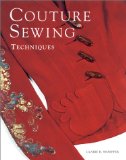Ms. Shaeffer has spent several decades studying, using, and researching traditional couture techniques, acquiring a collection of garments and reference materials. As she discusses in the introduction, she chose to focus on construction techniques in this book rather than design, draping, pattern making, etc. She also carefully selected those construction techniques she felt would be of most use to the home sewer.
She begins with a history of haute couture and a discussion of just what makes something "couture" (according to one industry professional, the distinguishing feature is the amount of handwork). Along the way we learn about the process of ordering a couture garment as well as what goes on behind the scenes during actual garment construction. I found this section one of the most fascinating in the book - I love learning about the process of executing any complicated endeavor.
Handwork is the heart of couture construction, and so early on we have a review of basic hand sewing techniques and tools.
- Needles and their uses
- Threads and their uses
- Tools
- Stitches, including how to start and end a line of stitching
- General workroom techniques
The bulk of the book consists of specific construction elements, the couture method of executing those elements - often with a comparative discussion of the relevant ready-to-wear methods - and practical application for the home sewer. Ms. Shaeffer provides many examples of actual couture garments - from Dior to Adrian to Vionnet - many of which use very clever solutions to construction problems and which also demonstrate the techniques she is documenting. Among the many topics covered are
- Pressing tools and techniques
- Seam finishes
- Hems
- Closures
- Pleated skirts
- Fitting a basic bodice
- Stays
- Sleeves (an entire chapter!)
- Pockets
- Tailoring basics (this one chapter alone is worth the price of the book)
- The iconic Chanel suit
- Eveningwear
Understanding the type of work that goes into the highest-end clothing has changed my approach to clothing construction for both streetwear and costumes. I can actually tell the difference in how garments fit and hang when I take the time to apply the techniques I learned in Couture Sewing Techniques. I cannot recommend the book highly enough.



